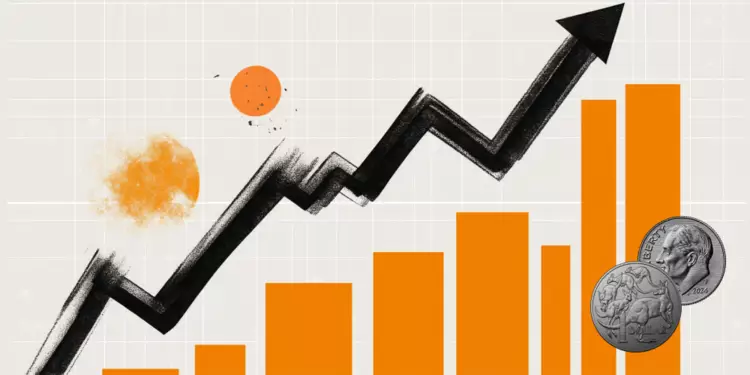In a striking development on the global economic stage, the Australian Dollar (AUD) is gaining momentum, defying downward pressures largely emanating from its counterpart, the US Dollar (USD). The recent fluctuations can be attributed to persistent tariff uncertainties and looming recession fears in the United States. As the global economy grapples with relentless challenges, Australia stands out with a position that combines resilience with caution. The factors influencing this dynamic are not just economic but also political, creating a complex matrix of interdependencies that traders and investors must navigate.
Consumer Inflation Expectations Reveal Notable Shifts
One of the pivotal indicators affecting currency strength is consumer inflation expectations. Recent data from Australia indicates a noticeable decline in consumer expectations for inflation, dropping from 4.6% in February to 3.6% in March. This decrease may spark concerns regarding consumer confidence, yet it simultaneously eases pressure on the Reserve Bank of Australia (RBA) to initiate further rate cuts. Investors are increasingly attuned to these subtle shifts, realizing that while lower inflation expectations may signal economic challenges, they could also provide a cushion against aggressive monetary policy adjustments that often destabilize currencies.
US Economic Indicators Stir Market Sentiment
Across the Pacific, the status of the US economy remains uncertain as the latest Consumer Price Index (CPI) report paints a cooler picture of inflation, with both headline and core rates easing faster than anticipated in February. The effective slowdown in inflation rates—from 3.0% to 2.8% on a yearly basis—is a double-edged sword; it alleviates some pressure off the Federal Reserve but raises questions about the overall health of the US economy. This dichotomy fosters speculation regarding interest rate cuts, which could result in a weaker US dollar, further providing space for the AUD to flourish.
Trade Tensions: A Growing Source of Instability
The specter of tariffs looms heavily, particularly as the Trump administration continues to grapple with trade dynamics. Though the president recently backtracked on imposing increased tariffs on Canadian steel and aluminum, he confirmed that 25% tariffs on all imported steel and aluminum are set to take effect. This ongoing trade wars not only impact US relations with allies but also creates a ripple effect on global markets, including Australia. As Prime Minister Anthony Albanese noted, Australia’s refusal to retaliate with reciprocal tariffs is a calculated decision, aimed at safeguarding local consumers from inflated costs—a commendable policy move that underscores the nation’s commitment to economic stability.
Australia’s Robust Growth: A Beacon of Hope
Amidst these tumultuous currents, it’s important to emphasize that Australia’s economic outlook appears brighter than that of many nations. The economy has outperformed expectations recently, marking its first acceleration in growth in over a year. Such robust performance can offer a compelling narrative for the AUD, inviting both local and foreign investors to engage with the market. The parameters set by the RBA are pivotal; they are navigating through convoluted waters, balancing between stimulating growth and curbing inflation.
Technical Analysis: The AUD/USD Pairing Points Towards Possibilities
Presently, the AUD/USD pairing is positioned around 0.6320, revealing encouraging technical indicators. With the Australian Dollar climbing above the nine-day Exponential Moving Average (EMA), there’s a tangible bullish momentum. The 14-day Relative Strength Index (RSI) gently hovers above 50, inciting optimism among traders that the currency pair could further ascend to the three-month high of 0.6408, last achieved on February 21. However, a cautious eye must be kept on immediate support levels at 0.6307 and 0.6304. If breached, there could be a significant shift in short-term momentum, suggesting the need for strategic trading signals.
Global Trade: The Ripple Effects of Policy Decisions
The Australian economic landscape is further complicated by international trade relations, particularly with China and the US. Both nations are entrenched in a stalemate over tariffs, with ongoing negotiations yielding little progress. Chinese tariffs on Canadian products are a reminder of how interconnected these economic conflicts have become. As the world watches and waits, it’s clear that the economic decisions made in one country are apt to reverberate globally, affecting currencies and trade balances far beyond their borders.
Ultimately, the AUD’s trajectory in the face of prevailing challenges deserves to be observed with a discerning perspective. While the external conditions remain volatile, Australia’s strategic decisions and growing economic indicators present a refreshing divergence from the broader market uncertainty, lending a stronger narrative to the Australian Dollar. The inherent unpredictability of the global economy necessitates both wise foresight and immediate action, but the recent strength of the AUD signifies potential and resilience that could carry it through the storm ahead.

